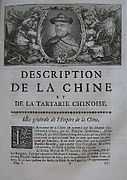Jean-Baptiste Du Halde


Jean-Baptiste Du Halde born in Paris on 1 February 1674 and died 18 August 1743. Du Halde was a French Jesuit historian specializing in China. He did not travel to China, but collected seventeen Jesuit missionaries' reports and provided encyclopedic survey of the history, culture and society of China and "Chinese Tartary," that is, Manchuria.
Voltaire said of Du Halde's work: "Although it is developed out of Paris, and he hath not known the Chinese, [he] gave on the basis of the memoirs of his colleagues, the widest and the best description the empire of China has had worldwide.".[1]
Career
Du Halde entered the Society of Jesus in 1692 and became Professor at the College of Paris succeeding Charles Le Gobien. From 1711 to 1743 he oversaw the publication of Letters edifying and curious, written for Foreign Missions, by Jesuit missionaries in China, published in 34 volumes ranges between 1703 and 1776. He wrote prefaces for volumes IX to XXVI. He was also Secretary of Michel Le Tellier and confessor to son of the regent in 1729.
Du Halde is also the author of writings in Latin as well as a treatise entitled Le Sage chrétien, ou les Principes de la vraie sagesse, pour se conduire chrétiennement dans le monde (The Christian Sage, or the principles of true wisdom, to lead a Christian in the world), published in 1724.
The General History of China
Drawn from the Jesuit Lettres édifiantes et curieuses and unpublished reports containing translations of Chinese texts of various origins, its geographical description, historical, chronological, political and physical of the empire of China and "Chinese-Tartary" appeared in Paris in four volumes in 1735 and was reprinted in the Netherlands in 1736. It had a significant impact on European society in the 18th century. The philosophers of the Enlightenment drew on it for their thoughts and controversies about religions, cultures and customs, while European manufacturers discovered the secrets of Chinese geography and the first map of the Korea by Jean-Baptiste Régis, and 42 maps of Chinese provinces by Jean Baptiste Bourguignon d'Anville
Besides a very detailed geographical description, the book gave encyclopedic coverage of all aspects of Chinese civilization: the emperors and the government; the military and police institutions; the nobility; agriculture and handicrafts; the "genius," the "glory" and the appearance of Chinese religion, ethics and ceremonies, science and medicine, money and commerce, language and writing system, the production of porcelain and silkworm breeding. There is also an abstract of the explorations of Vitus Bering, which is the first European description of Alaska. The book was very quickly added to all academic libraries and is translated into most European languages.
It was published in 1738, and was soon reprinted, as The General History of China Containing a Geographical, Historical, Chronological, Political and Physical Description of the Empire of China, Chinese-Tartary, Corea, and Thibet; Including an Exact and Particular Account of Their Customs, Manners, Ceremonies, Religion, Arts, and Sciences : The Whole Adorn'd with Curious Maps, and Variety of Copper-Plates. The work sparked the enthusiasm for China which seized England for several generations.
See also
References
- Isabelle Landry, La Preuve par la Chine : la Description de J.-B. Du Halde, jésuite, 1735, Éditions de l'École des hautes études en sciences sociales, Paris, 2002.
External links
- Jean-Baptiste Du Halde (1736). Description géographique, historique, chronologique, politique, et physique de l'empire de la Chine et de la Tartarie chinoise, enrichie des cartes générales et particulieres de ces pays, de la carte générale et des cartes particulieres du Thibet, & de la Corée; & ornée d'un grand nombre de figures & de vignettes gravées en tailledouce (in French). La Haye: H. Scheurleer. v.2, v.3, v.4
- J.-B Du Halde (1741), The General History of China: containing a geographical, historical, chronological, political and physical description of the empire of China, Chinese-Tartary, Corea, and Thibet ; including an exact and particular account of their customs, manners, ceremonies, religion, arts and sciences (3rd ed.), London: J. Watts v.2, v.3, v.4
Notes
- ↑ Le Siècle de Louis XIV, Catalogue de la plupart des écrivains français qui ont paru dans le Siècle de Louis XIV, pour servir à l’histoire littéraire de ce temps, 1751.
|